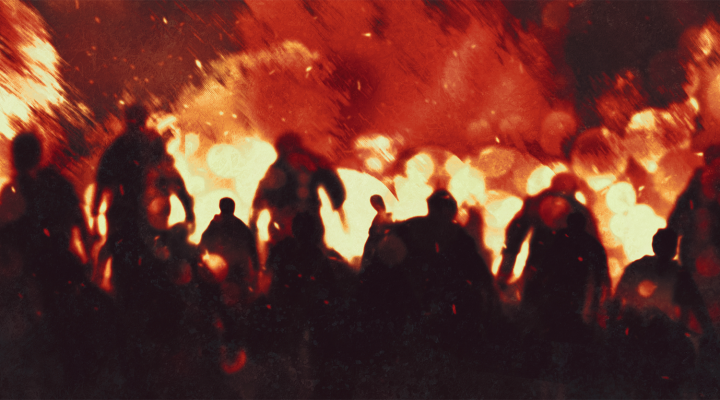Two apocalyptic movements bracket America’s democratic crisis. One predicts a future chaos; the other airs a past history of grievances.
The future and the past impinge upon the present to paralyze the potential for positive action. One looks to the end of the world; the other to a mythical world of Christian nationalism and white male victimization.

Rodney Kennedy
Add apocalyptic fervor to the fear and rage of many white evangelical males and you discover two dominant tropes: the rapture and the “lost world” when men were men and in charge.
Both the future and the past are employed to create a present filled with fear and destruction, a rapture and a rupture.
The rapture offers the apocalyptic future for the fearful. “The lost world” incorporates white male delusions and melancholy for a world that never existed, a world where “men were men” and women did what they were told to do. These two apocalyptic tropes merge in an evangelical faith mostly white and Pentecostal to produce calls for “a strong man,” for male leadership, for warriors. This overlooks the reality that America doesn’t need more apocalyptic males; America needs more suffering, sacrificing servants.
“America doesn’t need more apocalyptic males; America needs more suffering, sacrificing servants.”
The apocalypse sells
Nothing sells in America like apocalyptic messages. Ever since Tim LaHaye turned the Left Behind series into huge profits, the rapture preachers have been coming out of the woodpile with deceptive clownery and outrageous visions.
The apocalyptic sizzles in American religion. The religious apocalyptic bewails the fallen nature of America and the return of Jesus to rapture his church. From the halls of Congress to the pulpits of our churches, the apocalyptic rules — and sells.
More than half the members of Congress claim to believe in the rapture. At least 80 million American Christians believe in the rapture. In Birmingham, Ala., megachurch pastor Chris Hodges (Church of the Highlands) offered a series called “The Second Coming” for the month of August 2022. Robert Jeffress, pastor of First Baptist Church of Dallas, has published two books that are apocalyptic from cover to cover, Countdown to the Apocalypse and Twilight’s Last Gleaming. David Jeremiah has produced After the Rapture: An End Times Guide to Survival, The Book of Signs, The World of the End, and Where Do We Go from Here?
“Apocalypse means revelation,” says Northrop Frye, and the apocalyptic “reveals only on its own terms.” The language of apocalyptic dwells in symbolic language and hard-to-decipher images. The metaphorical, analogical, allegorical and symbolic nature of apocalyptic texts make them easy prey for the outlandish, imaginative and emotional preachers of end times. There are as many interpretations of Revelation as there are preachers willing to literalize symbolic language.
Richard Hughes suggests that a variety of themes converged in America to produce this apocalyptic fever: a chosen people, a Christian nation with a millennial mission, an innocent and righteous people opposed by the forces of evil. Robert Jewett argues that the rapture appeals because it is an escape for the evangelical Christian, a religious “golden parachute” in reverse when the world falls apart.
“There is a crisis, but the religious prescriptions are false.”
Apocalyptic resonates with fearful folk because it portends crisis, impending catastrophe, prophecy, a promise of salvation. In secular apocalyptic messages we get widespread destruction, economic collapse, nuclear winter, climate change and pandemics. In the religious version we get the four horsemen of the apocalypse — pestilence, war, famine and death. We also are treated with the antichrist, Armageddon, the tribulation and the rapture, not necessarily in that order.
Taking root among evangelicals
The secular apocalypse is based on actual science; the religious one teeters on the dream of a Scottish teenager, the dispensational theology of a former Anglican priest and the overwrought imaginations of American evangelical preachers. There is a crisis, but the religious prescriptions are false. It’s like going to the doctor and getting a false diagnosis.
Apocalyptic prophecies flourish among many evangelicals. Any Sunday school veteran from the evangelical universe has been well-versed in the rapture-tribulation-Armageddon-millennial reign scenario. The difficulty for the doomsday prophets is that while there’s a boom in their book sales, the rapture stubbornly refuses to happen. Jesus doesn’t show up as expected, as demanded.
A frustration sinks in for the apocalyptic vision. Harold Camping, a fundamentalist rapture preacher, predicted the world would end. He was wrong, not once or twice, but three times. He died having lost faith in the rapture. Camping is a trope of apocalyptic despair.
White male victimization
There is a correlating trope of apocalyptic despair — white male victimization. The despair and melancholy of white males who feel stripped of power experience what they think is a loss of their way of life. They fantasize about a return to the time when men were the undisputed rulers of all. The illusion is apocalyptic in nature because of its potential for violence. Perhaps the most powerful emotion fueling the almost cult-like support of ex-president Donald Trump has been the strong man trope promising to make men strong again, winners again, in charge again.
The failure of the prophecy about the rapture correlates to the melancholy of white males feeling stripped of power and experiencing what they think is a loss of a way of life. Philosopher Slavoj Zizek says, “The melancholic confuses loss with lack.”
White males produce a melancholia where they grieve the loss of their status and “wholeness.”
“Apocalyptic manhood,” Casey Ryan Kelly concludes, “is the fantasy that beneath modernity exists an essential, timeless and sustainable version of manhood.”
“There’s a sense among white males that the world they think they constructed and controlled has been stolen from them.”
There’s a sense among white males that the world they think they constructed and controlled has been stolen from them. They are assaulted by gays, feminists, the ACLU, “wokeness,” Critical Race Theory, socialists, university professors, elitists and liberals.
For a visual, recall the peaceful street protest of Black Lives Matter in a St. Louis suburb that brought an affluent white lawyer and his wife out of their mansion to point weapons at the protesters. Martin Marty once observed that they believe they have been left out of everyone else’s “rights” movement.
This matters to Christians for two reasons: No group works harder at maintaining male superiority than evangelicals, and apocalyptic despair is a white male death wish. Many representatives of this demographic believe that for the church to remain healthy and strong, its men must conform to particular standards of masculinity that, they argue, stem directly from biblical truth.
Death and destruction
White masculine pictures of victimhood reveal a compulsion toward death and self-destruction. The only recourse for the crisis of masculinity is through the destruction of feminized, homosexualized society. And this underworld is promoted by, preached on and propagated by evangelical preachers and assorted conspiracy theorists.
This is how we get Alex Jones insisting it was his right to claim the Sandy Hook murders were staged by the government. As incongruous as it sounds, evangelical preachers and QAnon work in partnership to feed the death wish of white males.
Many evangelicals uphold “masculine” Christianity. An emphasis on masculinity is not new to the church, nor is the motivation behind this emphasis. Evangelist Billy Sunday preached and performed a “masculine” gospel. Similar concerns for the church fuel the masculine Christianity of the 21st century.
The male-ordered hierarchy theology is clear: The man is the moral leader of the family. He is to be obeyed. The wife and children are to be submissive. This is an evil world and thus a strong male is required to protect the family because Mommy can’t do it.
“That white males accepted this argument doesn’t make it true, but it retains its power.”
Politicians have relied heavily on the myth of the Black rapist to generate and sustain fears and anxieties about a racially inclusive society since the 19th century. Donald Trump picked up the ancient trope by calling Mexican immigrants “rapists.” That white males accepted this argument doesn’t make it true, but it retains its power. There is competition in the world, and only the man can win those competitions.
The apocalyptic man, secular or religious, is no different from man in any age. Men always are struggling with identity, insecurity and the secret need to please while hiding it with bluster, braggadocio and defensive principles.
That bluster — like the sound and fury of apocalyptic preaching — needs a reality check: The rapture hasn’t happened because it is fake, unbiblical and built on fabrications of Scripture. The world of illusion where white men ruled is not coming back either.
Rapture and the “lost world” are not real, but both expose an underlying sense of crisis that is dangerous. The mythic narratives of white male supremacy, American exceptionalism, a righteous and persecuted people are all dangerous tropes with the potential for doing devastating damage to Christian faith and democracy.
Opposing these movements is essential to our survival.
Rodney W. Kennedy is a pastor in New York state and serves as a preaching instructor at Palmer Theological Seminary. He is the author of nine books, including the newly released The Immaculate Mistake, about how evangelical Christians gave birth to Donald Trump.
Related articles:
White resentment is like an abusive lover who would rather kill than lose control | Opinion by Susan K. Smith
Nice white women participate in white supremacy too | Opinion by Laura Ellis
Let’s be clear: Putin’s invasion of Ukraine is not about the rapture and Russia in biblical prophecy | Analysis by Rodney Kennedy
What’s wrong with ‘Left Behind’? | Analysis by Mark Wingfield


